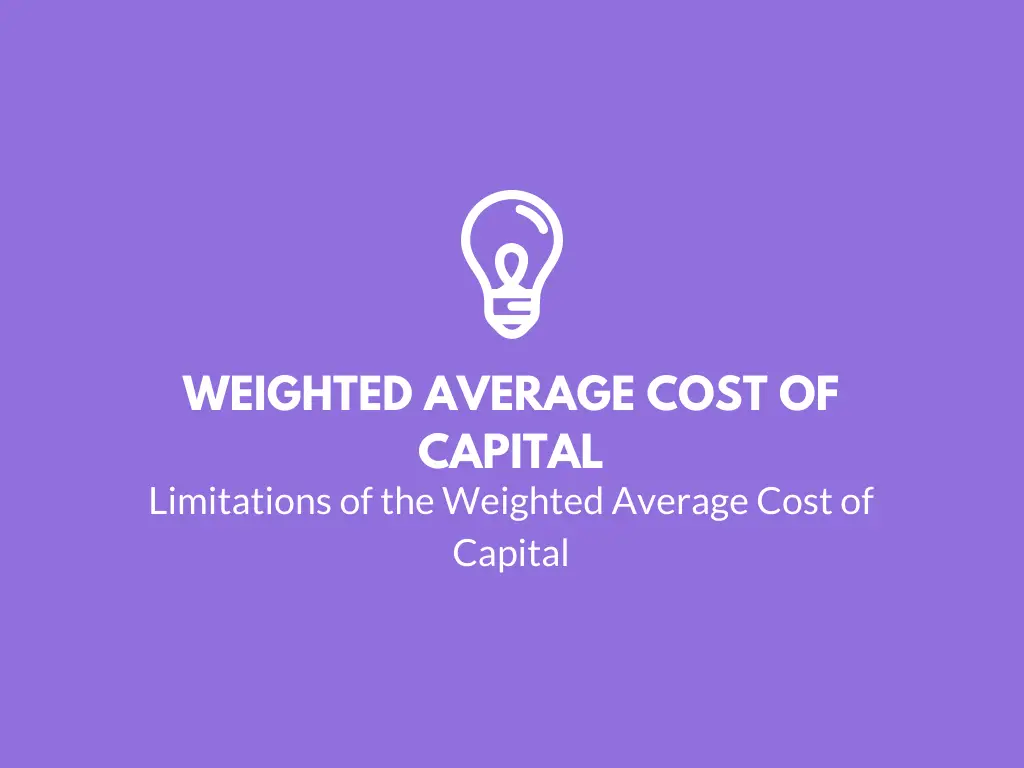The Weighted Average Cost of Capital (WACC) is the required rate of return on a business organization.
A business organization usually compares a new project’s Internal Rate of Return (IRR) against the organization’s WACC.
So, WACC is the minimum rate for an organization to accept an investment project. Despite many advantages, the WACC has many limitations also and they are described below:

- The cost of equity and cost of debt is required to determine for calculating the WACC which is difficult to estimate for private companies due to lack of publicly available information. For public companies, there are various methods for calculating the cost of equity. There is no single formula that can be used in every company but assuming the cost of equity is difficult for calculating WACC.
- The WACC carries an assumption that the debt to equity ratio will remain constant. For the forecasting value of a company, it is assumed that the WACC will remain constant and the debt to equity ratio will also remain constant. But it is impossible because the debt to equity ratio changes and so will the WACC.
- The WACC can be lowered by increasing debts which will create problems. If the debt is added beyond the optimal capital structure it will increase the present value of the cost of financial distress.
The WACC uses assumptions and there are problems with the assumptions. These are:
- Profitability in a market is totally uncertain with changing demands, needs, competition, and prices. It is required to consider the fact of understanding the return on that capital when determining the cost of capital. Because the profitability should exceed the cost of borrowing the fund.
- Another important fact to consider is the opportunity cost which also changes over time. The cost of equity is made by identifying the risks of a particular project and comparing it with other similar projects. In this case, the opportunity costs should be considered both for investors and the business itself.
- A project has some unforeseen risks and for these risks, capital is required that has not been considered in the forecast. When the amount of required capital increases, the financial risk also increases. So, more capital requirements during the project also increase the overall cost of capital.
WACC is highly sensitive to many factors. A company can control its capital structure. With an intention of making the cost of capital lower, a company can increase the level of debt. A company’s cost of capital is influenced by its investment activities.
When a company merges or acquires another company, the WACC will depend on sources of capital.
It is also the decision of management which sources of capital are suitable. A company cannot control economic factors such as inflation, so interest rates fluctuate.
A change in a company’s cost of debt also affects the tax rate which is imposed by a country’s fiscal policy. The term cost of equity also relies on the economy of the country because it depends on the market.
The Weighted Average Cost of Capital (WACC) is complex in its application due to the reasons such as the need to know the specific rate of return.
For determining the cost of equity, different methods can be used such as the dividend discount model, risk premium, CAPM model. There are inherent problems with each model because at least one of the variables can be an estimation.
For example, when using the Gordon growth model, the growth rate is an assumption and when using CAPM, the risk premium is an assumption using historical data.
The risk-free rate and risk premium are used to estimate the cost of debt and there are also problems with both.
As the amount of debt increases a higher risk premium is required. It gets more difficult to estimate the company’s WACC depending on the company’s capital structure complexities.
The WACC is not suitable for accessing risky projects because to reflect the higher risk the cost of capital will be higher.
Different people use different formulas to calculate WACC which gives different results and it also makes it difficult to accept WACC in some cases.
It can be stated at the end, WACC is important in the stock market for stock valuation. But the limitations are also necessary for investors to know whether the WACC will be helpful for them or not because forecasts are not sure things. However, this will also depend on the nature of the business.
